MITSUBISHI COLT 2008 Owner's Manual (in English)
Manufacturer: MITSUBISHI, Model Year: 2008, Model line: COLT, Model: MITSUBISHI COLT 2008Pages: 450, PDF Size: 14.57 MB
Page 161 of 450
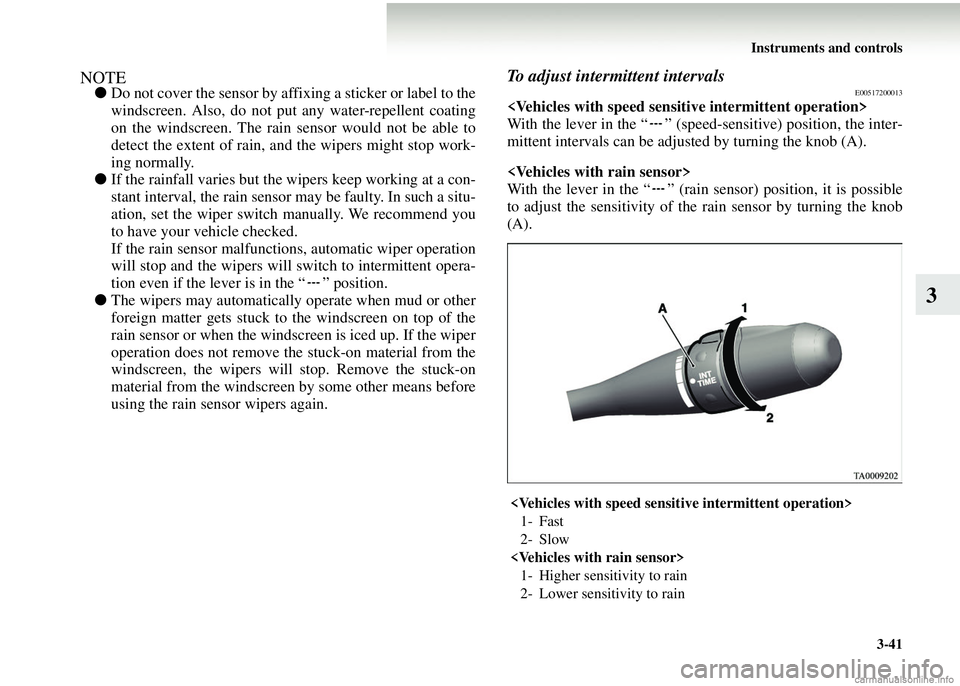
Instruments and controls3-41
3
NOTE●Do not cover the sensor by affixing a sticker or label to the
windscreen. Also, do not put any water-repellent coating
on the windscreen. The rain sensor would not be able to
detect the extent of rain, and the wipers might stop work-
ing normally.
● If the rainfall varies but the wipers keep working at a con-
stant interval, the rain sensor may be faulty. In such a situ-
ation, set the wiper switch manually. We recommend you
to have your vehicle checked.
If the rain sensor malfunctions, automatic wiper operation
will stop and the wipers will switch to intermittent opera-
tion even if the lever is in the “ ” position.
● The wipers may automatically operate when mud or other
foreign matter gets stuck to the windscreen on top of the
rain sensor or when the windsc reen is iced up. If the wiper
operation does not remove the stuck-on material from the
windscreen, the wipers will stop. Remove the stuck-on
material from the windscreen by some other means before
using the rain sensor wipers again.
To adjust intermittent intervalsE00517200013
With the lever in the “ ” (speed-sensitive) position, the inter-
mittent intervals can be adjusted by turning the knob (A).
With the lever in the “ ” (rain sensor) position, it is possible
to adjust the sensitivity of the rain sensor by turning the knob
(A).
1- Fast
2- Slow
2- Lower sensitivity to rain
Page 162 of 450
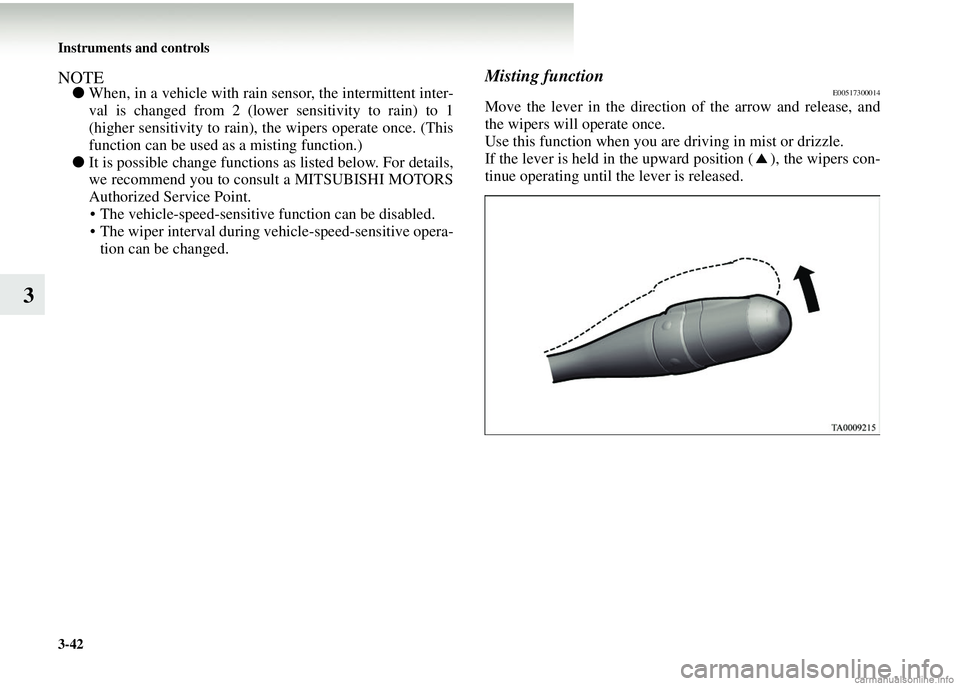
3-42 Instruments and controls
3
NOTE●When, in a vehicle with rain sensor, the intermittent inter-
val is changed from 2 (lower sensitivity to rain) to 1
(higher sensitivity to rain), the wipers operate once. (This
function can be used as a misting function.)
● It is possible change functions as listed below. For details,
we recommend you to consult a MITSUBISHI MOTORS
Authorized Service Point.
• The vehicle-speed-sensitive function can be disabled.
• The wiper interval during vehicle-speed-sensitive opera-
tion can be changed.
Misting functionE00517300014
Move the lever in the direction of the arrow and release, and
the wipers will operate once.
Use this function when you are driving in mist or drizzle.
If the lever is held in the upward position ( ), the wipers con-
tinue operating until the lever is released.
Page 163 of 450
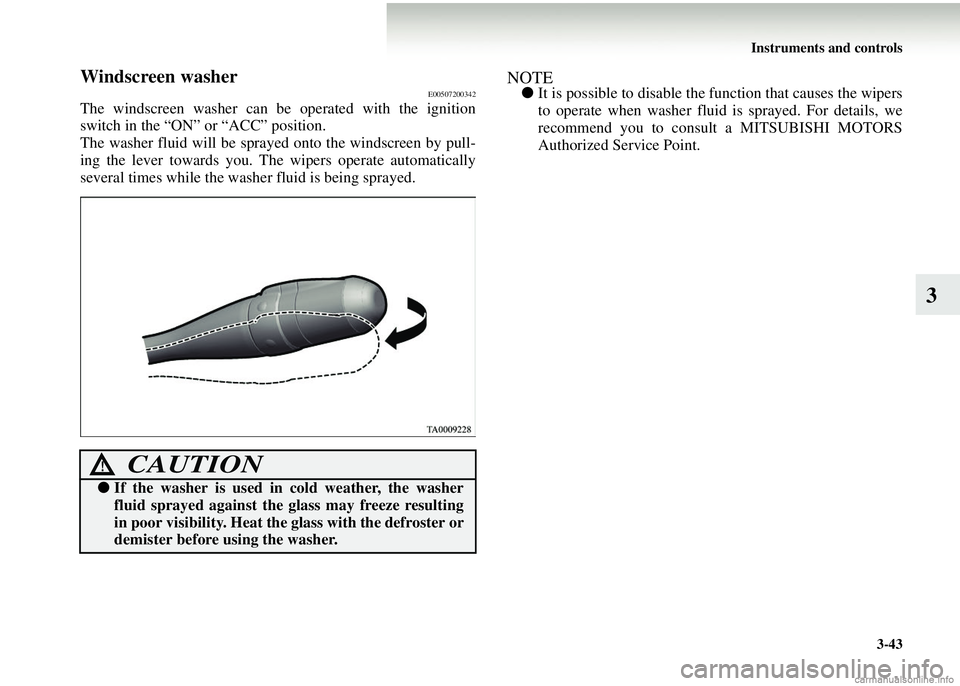
Instruments and controls3-43
3
Windscreen washerE00507200342
The windscreen washer can be operated with the ignition
switch in the “ON” or “ACC” position.
The washer fluid will be sprayed onto the windscreen by pull-
ing the lever towards you. Th e wipers operate automatically
several times while the washer fluid is being sprayed.
NOTE● It is possible to disable the function that causes the wipers
to operate when washer fluid is sprayed. For details, we
recommend you to consult a MITSUBISHI MOTORS
Authorized Service Point.
CAUTION!
● If the washer is used in cold weather, the washer
fluid sprayed against the glass may freeze resulting
in poor visibility. Heat the glass with the defroster or
demister before using the washer.
Page 164 of 450
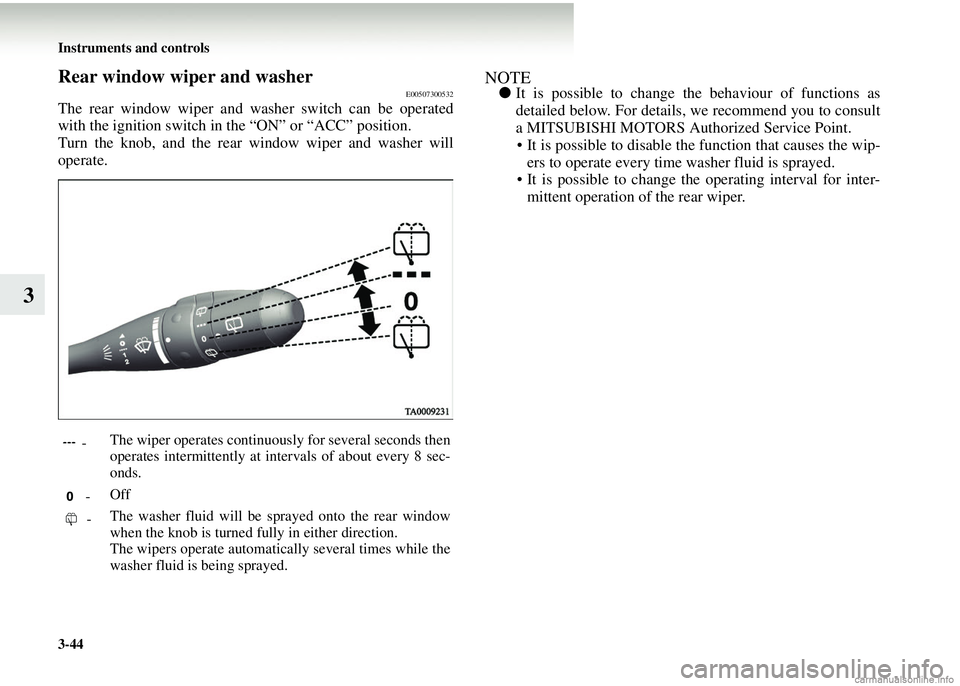
3-44 Instruments and controls
3
Rear window wiper and washerE00507300532
The rear window wiper and washer switch can be operated
with the ignition switch in the “ON” or “ACC” position.
Turn the knob, and the rear window wiper and washer will
operate.
NOTE● It is possible to change the behaviour of functions as
detailed below. For details, we recommend you to consult
a MITSUBISHI MOTORS Authorized Service Point.
• It is possible to disable the function that causes the wip-
ers to operate every time washer fluid is sprayed.
• It is possible to change the operating interval for inter-
mittent operation of the rear wiper.
- The wiper operates continuously for several seconds then
operates intermittently at intervals of about every 8 sec-
onds.
- Off
- The washer fluid will be sprayed onto the rear window
when the knob is turned fully in either direction.
The wipers operate automatically several times while the
washer fluid is being sprayed.
Page 165 of 450
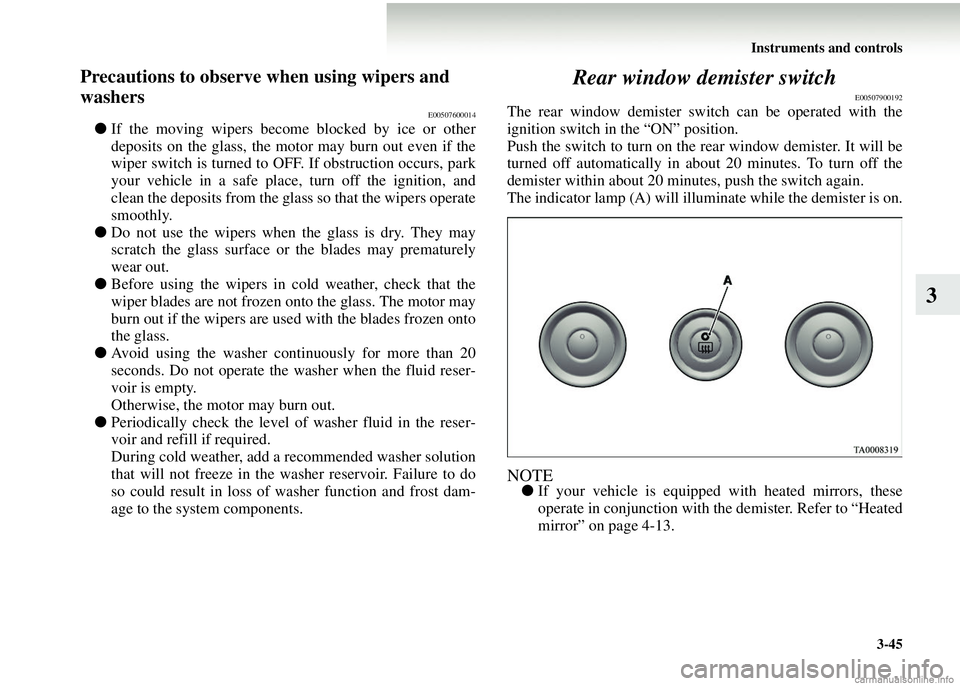
Instruments and controls3-45
3
Precautions to observe when using wipers and
washers
E00507600014
●If the moving wipers become blocked by ice or other
deposits on the glass, the motor may burn out even if the
wiper switch is turned to OFF. If obstruction occurs, park
your vehicle in a safe place, turn off the ignition, and
clean the deposits from the glass so that the wipers operate
smoothly.
● Do not use the wipers when the glass is dry. They may
scratch the glass surface or the blades may prematurely
wear out.
● Before using the wipers in co ld weather, check that the
wiper blades are not frozen on to the glass. The motor may
burn out if the wipers are used with the blades frozen onto
the glass.
● Avoid using the washer continuously for more than 20
seconds. Do not operate the washer when the fluid reser-
voir is empty.
Otherwise, the motor may burn out.
● Periodically check the level of washer fluid in the reser-
voir and refill if required.
During cold weather, add a recommended washer solution
that will not freeze in the wash er reservoir. Failure to do
so could result in loss of washer function and frost dam-
age to the system components.
Rear window demister switch
E00507900192
The rear window demister switch can be operated with the
ignition switch in the “ON” position.
Push the switch to turn on the rear window demister. It will be
turned off automatically in about 20 minutes. To turn off the
demister within about 20 minutes, push the switch again.
The indicator lamp (A) will illuminate while the demister is on.
NOTE● If your vehicle is equipped with heated mirrors, these
operate in conjunction with the demister. Refer to “Heated
mirror” on page 4-13.
Page 166 of 450
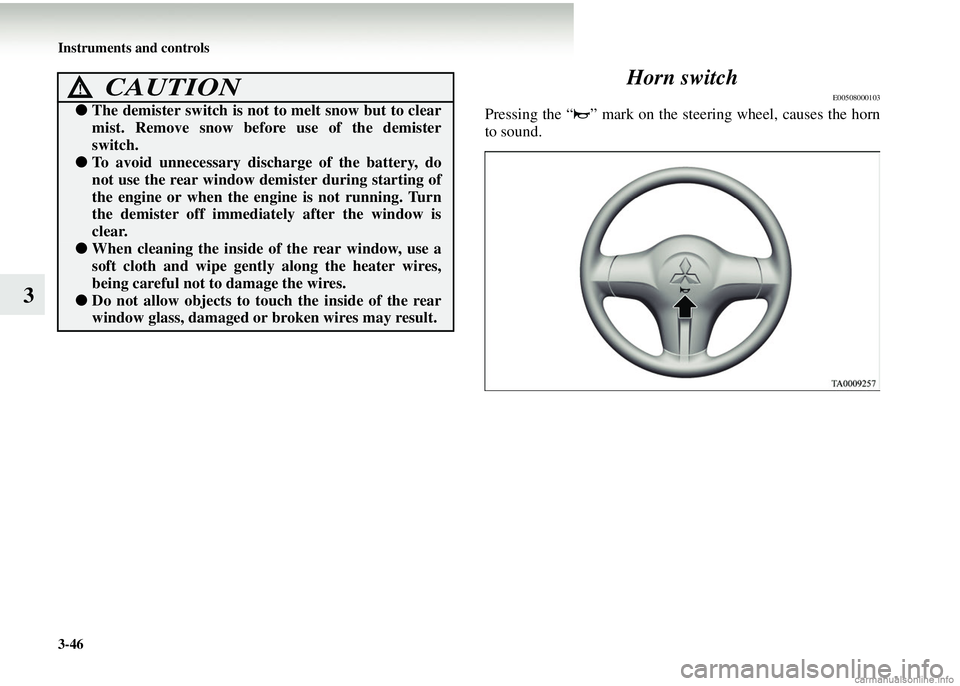
3-46 Instruments and controls
3Horn switch
E00508000103
Pressing the “ ” mark on the steering wheel, causes the horn
to sound.
CAUTION!
●
The demister switch is not to melt snow but to clear
mist. Remove snow before use of the demister
switch.
●To avoid unnecessary disc harge of the battery, do
not use the rear window de mister during starting of
the engine or when the en gine is not running. Turn
the demister off immediat ely after the window is
clear.
● When cleaning the inside of the rear window, use a
soft cloth and wipe gently along the heater wires,
being careful not to damage the wires.
●Do not allow objects to touch the inside of the rear
window glass, damaged or broken wires may result.
Page 167 of 450
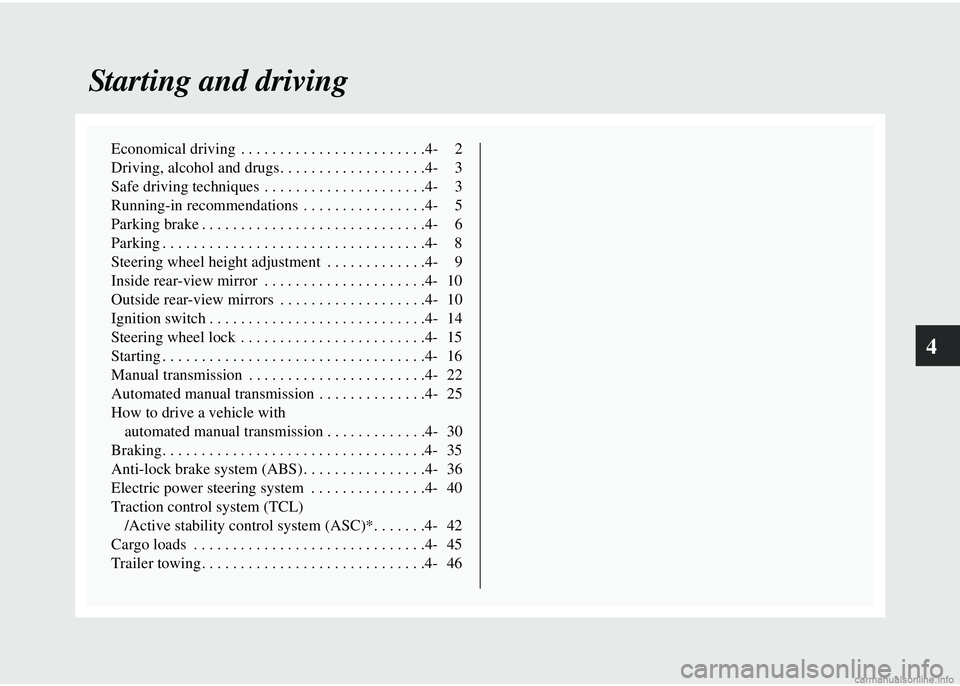
4
Starting and driving
Economical driving . . . . . . . . . . . . . . . . . . . . . . . .4- 2
Driving, alcohol and drugs. . . . . . . . . . . . . . . . . . .4- 3
Safe driving techniques . . . . . . . . . . . . . . . . . . . . .4- 3
Running-in recommendations . . . . . . . . . . . . . . . .4- 5
Parking brake . . . . . . . . . . . . . . . . . . . . . . . . . . . . .4- 6
Parking . . . . . . . . . . . . . . . . . . . . . . . . . . . . . . . . . .4- 8
Steering wheel height adjustment . . . . . . . . . . . . .4- 9
Inside rear-view mirror . . . . . . . . . . . . . . . . . . . . .4- 10
Outside rear-view mirrors . . . . . . . . . . . . . . . . . . .4- 10
Ignition switch . . . . . . . . . . . . . . . . . . . . . . . . . . . .4- 14
Steering wheel lock . . . . . . . . . . . . . . . . . . . . . . . .4- 15
Starting . . . . . . . . . . . . . . . . . . . . . . . . . . . . . . . . . .4- 16
Manual transmission . . . . . . . . . . . . . . . . . . . . . . .4- 22
Automated manual transmission . . . . . . . . . . . . . .4- 25
How to drive a vehicle with automated manual transmission . . . . . . . . . . . . .4- 30
Braking. . . . . . . . . . . . . . . . . . . . . . . . . . . . . . . . . .4- 35
Anti-lock brake system (ABS) . . . . . . . . . . . . . . . .4- 36
Electric power steering system . . . . . . . . . . . . . . .4- 40
Traction control system (TCL) /Active stability control syst em (ASC)*. . . . . . .4- 42
Cargo loads . . . . . . . . . . . . . . . . . . . . . . . . . . . . . .4- 45
Trailer towing. . . . . . . . . . . . . . . . . . . . . . . . . . . . .4- 46
Page 168 of 450
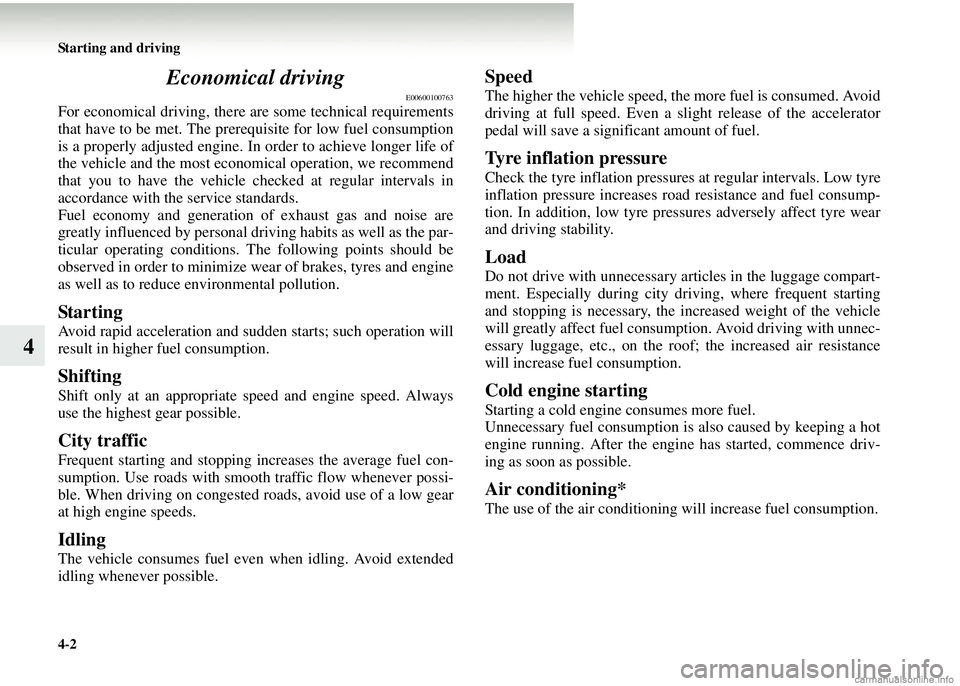
4-2 Starting and driving
4Economical driving
E00600100763
For economical driving, there ar
e some technical requirements
that have to be met. The prerequisite for low fuel consumption
is a properly adjusted engine. In order to achieve longer life of
the vehicle and the most economical operation, we recommend
that you to have the vehicle checked at regular intervals in
accordance with the service standards.
Fuel economy and generation of exhaust gas and noise are
greatly influenced by personal driving habits as well as the par-
ticular operating conditions. The following points should be
observed in order to minimize w ear of brakes, tyres and engine
as well as to reduce environmental pollution.
Starting
Avoid rapid acceleration and sudden starts; such operation will
result in higher fuel consumption.
Shifting
Shift only at an appropriate speed and engine speed. Always
use the highest gear possible.
City traffic
Frequent starting and stopping increases the average fuel con-
sumption. Use roads with smooth traffic flow whenever possi-
ble. When driving on congested roads, avoid use of a low gear
at high engine speeds.
Idling
The vehicle consumes fuel even when idling. Avoid extended
idling whenever possible.
Speed
The higher the vehicle speed, the more fuel is consumed. Avoid
driving at full speed. Even a slight release of the accelerator
pedal will save a significant amount of fuel.
Tyre inflation pressure
Check the tyre inflation pressure s at regular intervals. Low tyre
inflation pressure increases ro ad resistance and fuel consump-
tion. In addition, low tyre pres sures adversely affect tyre wear
and driving stability.
Load
Do not drive with unnecessary articles in the luggage compart-
ment. Especially during city dr iving, where frequent starting
and stopping is necessary, the increased weight of the vehicle
will greatly affect fuel consum ption. Avoid driving with unnec-
essary luggage, etc., on the ro of; the increased air resistance
will increase fuel consumption.
Cold engine starting
Starting a cold engine consumes more fuel.
Unnecessary fuel consumption is also caused by keeping a hot
engine running. After the engine has started, commence driv-
ing as soon as possible.
Air conditioning*
The use of the air conditioning will increase fuel consumption.
Page 169 of 450
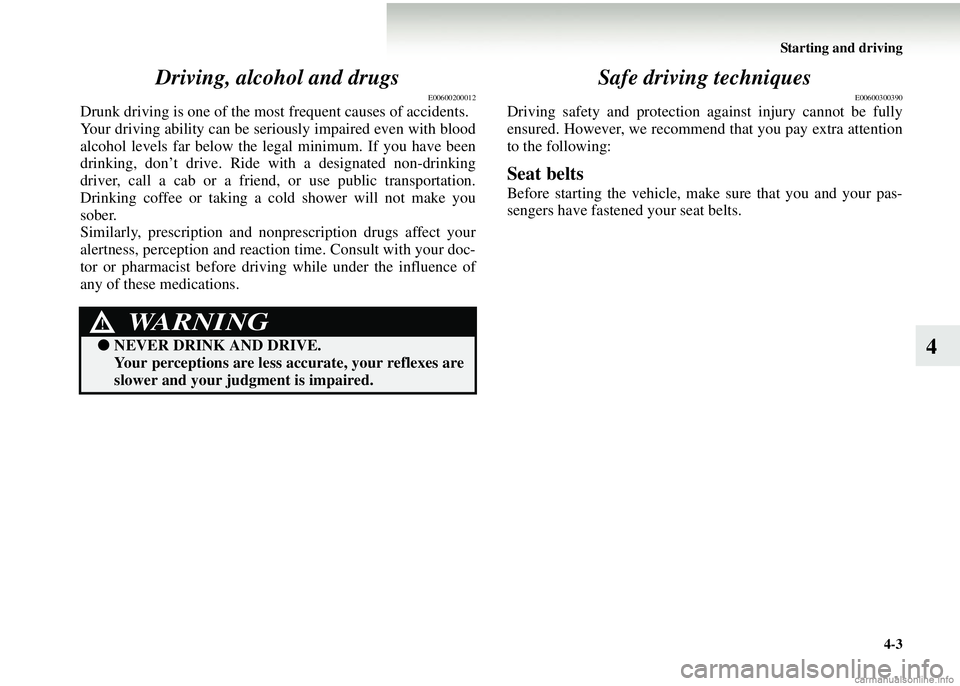
Starting and driving4-3
4
Driving, alcohol and drugs
E00600200012
Drunk driving is one of the most
frequent causes of accidents.
Your driving ability can be seriously impaired even with blood
alcohol levels far below the legal minimum. If you have been
drinking, don’t drive. Ride with a designated non-drinking
driver, call a cab or a friend, or use public transportation.
Drinking coffee or taking a cold shower will not make you
sober.
Similarly, prescription and nonprescription drugs affect your
alertness, perception and reaction time. Consult with your doc-
tor or pharmacist before driving while under the influence of
any of these medications.
Safe driving techniques
E00600300390
Driving safety and protection against injury cannot be fully
ensured. However, we recommen d that you pay extra attention
to the following:
Seat belts
Before starting the vehicle, make sure that you and your pas-
sengers have fastened your seat belts.
WARNING!
● NEVER DRINK AND DRIVE.
Your perceptions are less accurate, your reflexes are
slower and your judgme nt is impaired.
Page 170 of 450
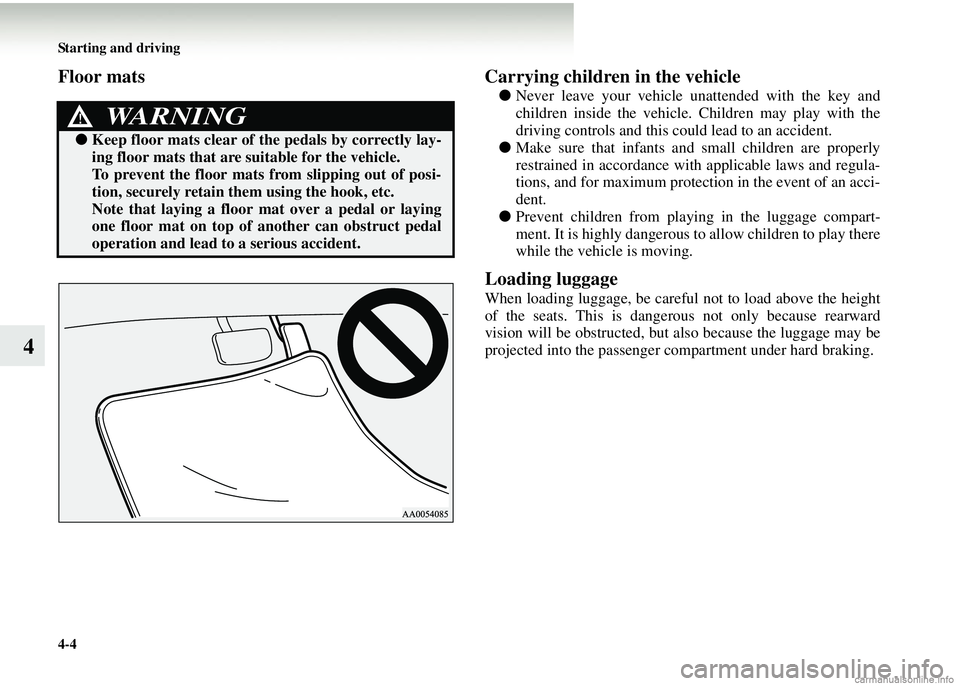
4-4 Starting and driving
4
Floor matsCarrying children in the vehicle
●Never leave your vehicle un attended with the key and
children inside the vehicle. Children may play with the
driving controls and this could lead to an accident.
● Make sure that infants and small children are properly
restrained in accordance with applicable laws and regula-
tions, and for maximum protecti on in the event of an acci-
dent.
● Prevent children fr om playing in the luggage compart-
ment. It is highly dangerous to allow children to play there
while the vehicle is moving.
Loading luggage
When loading luggage, be careful not to load above the height
of the seats. This is dange rous not only because rearward
vision will be obstru cted, but also because the luggage may be
projected into the passenger compartment under hard braking.
WARNING!
● Keep floor mats clear of th e pedals by correctly lay-
ing floor mats that are suitable for the vehicle.
To prevent the floor mats from slipping out of posi-
tion, securely retain th em using the hook, etc.
Note that laying a floor mat over a pedal or laying
one floor mat on top of an other can obstruct pedal
operation and lead to a serious accident.